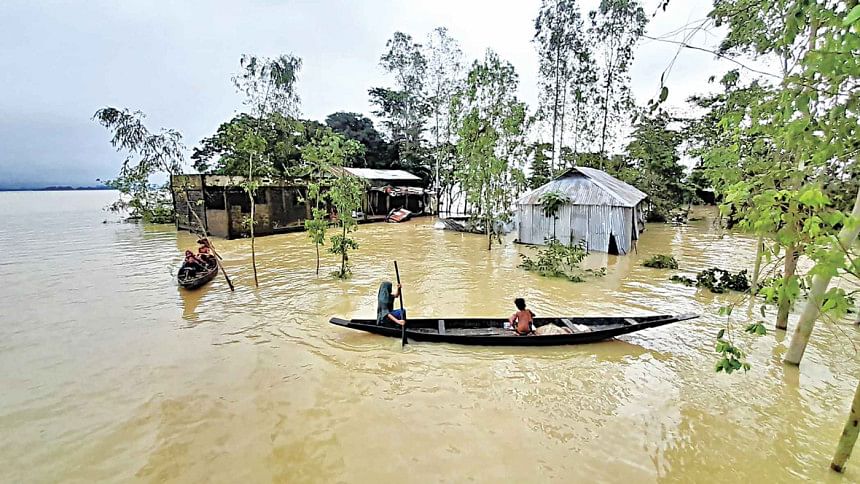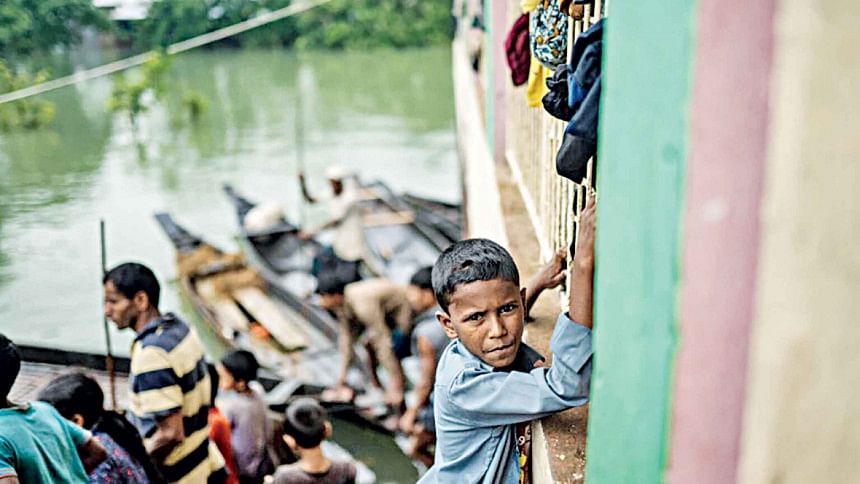The Sylhet floods are anything but normal

As you read this piece, the water is receding in Sunamganj, while the bodies surface. I say Sunamganj and not the northeast, because that is my hometown and I feel deeply connected to the struggles of the Sylhoti people – my people. And perhaps the problems in our media consumption and policy understanding around floods stem from exactly that sentiment: a false sense of proprietorship only when one's one skin or kin is on the line of fire – or water, as in this case.
On June 9, torrential rains started a little out of season in Sylhet and Sunamganj, along with in neighbouring Kishoreganj. It was downcast and pouring for five days straight in Ashar, but people thought little of it; locals have grown used to chaotic seasonal shifts that put their livelihoods in danger. The chief concern was storing whatever amount of collected grain that was miraculously saved from the flash floods during Baishakh, and keeping the next year safe along with it. But five days into the rain, when the waterline crept closer and closer to their porch, slow panic set in. This was not like other years, when the rain abated, and the water flushed out along the river and the lakes. It was as if someone had plugged up all the waterways and let the heavens loose. Days and nights felt like one as the skies remained perpetually dark, and soon whole villages became disconnected from one another as the water rose to engulf entire highways. Piling their belongings on top of one another until they reached the roof, one family realised too late that the water had gone above the door and was still rising. Frantic attempts to open it would be of no avail as the waves began to hit, and they slowly drowned in their home – seven members of a family, together.
That was one story out of millions. People losing a year's worth of grain, desperately trying to save property documents that had taken entire lives to sort, sleeping with livestock because that was the only remaining wealth, losing mothers, fathers and children to the water that would not cease to rise, and worst of all, finding no way to bury or burn their loved ones, let alone grieve. Human lives were not "disrupted" by floods, this was not a mere case of haor-bashis giving into the inevitable rising waters that give their land the nutrition that allows them to prosper the rest of the year. It was an unprecedented attack on their lives and livelihoods, equivalent to man-made disasters such as wars. It is no surprise, but is of deep concern, that in Dhaka, there is an inability to find flood victims' lives "relatable." The local and global audience look at flooding as an annual ritual – a sacrifice to a vengeful Mother Nature that gives as much as it takes. Flooding is not normal and the costs of it are not normal, and if we continue to normalise it in our narratives, we will not realise that we have not emerged into a post-flood Bangladesh.

Unfortunately, neither the prevention nor the aftercare for flooding can be approached without careful planning and implementation across government, non-government, and private sector entities. Meghalaya and Assam have stormy weather forecasts and experts warn of a second round of flooding in Sylhet, and it is already the worst flood in decades. With 72 percent of the division affected by the disaster, relief efforts need to be targeted to the most vulnerable families first in order to effectively prevent the more long-lasting impacts of flooding, such as the spread of waterborne diseases.
One of the common infrastructural requests by locals is the installation and maintenance of sluice gate-style dams to control the water flows in haors. In Sunamganj, for example, the creation of the Fandar-Khaal dam has left out the possibility of millions of tonnes of water making its way through Dekhar haor to the Surma River. The reason for building this dam was to save the farmlands on the other side of the dam, and it is perhaps worth questioning now whether the benefits have outweighed the significant flood costs that Sunamganj annually suffers as a result. Infrastructural projects such as these never receive enough scrutiny either at the national or local level, and their CBA (cost-benefit analysis) reports are hardly ever disclosed at the outset of the process.
But the inefficiencies of bureaucracy are not the only factors to blame. River embankments are subjected to highly contentious property rights cases. Although the embankments ought to be controlled and heightened as per government discretion, they are often managed by local thugs and the soil is sold for profit, effectively reducing the depth to the riverbed, and leaving more room for flooding. Enforcing embankment regulation, either through purchase of land or through existing measures, would be a preventative measure if only powerful locals did not stand in the way.
However, infrastructural changes may never be truly enough in a country so close to the sea level, and local governments must be empowered to treat floods in the northeast as cyclones are in the south. Multi-use plastic boats that can be reconditioned into planting beds in the dry season, radio-based communication devices for when the power is down, enlisted flood volunteers' records so that rescue operations are streamlined, local flood warning announcements, and dedicated shelter specifications are all readiness measures that would help UNOs and local government leaders build a connected and collaborated rescue effort, as opposed to the usual disparate and frantic one.
As the waters recede, many stories surface of local ingenuity – citizens bringing in gas cylinders into school shelters so hundreds could survive on cooked meals, families using beds as firewood, people collecting rainwater for drinking as the tube-wells go under, and countless more. There is great power in the collective, and it can only be utilised when we as a nation take on flood management the way we would do a fire or an earthquake – not as something to be managed in the aftermath with food and medicine, but as a phenomenon to be conquered with all the human innovation and resilience that a populace can muster.
And, perhaps then, the stories of a flooding Bangladesh will not be about statistics or a narrative, but about the uphill struggle of a human being fighting insurmountable odds, and in the most unlikely way, winning. Not a tragedy of commons, but a ballad for heroes.
Mastura Tasnim is a policy consultant working on local development, religiopolitics, and gender education

 For all latest news, follow The Daily Star's Google News channel.
For all latest news, follow The Daily Star's Google News channel. 



Comments